Varroa mites plague nearly all honeybee colonies. Regular monitoring is key so as to know when to treat and how efficient has been your treatment. To help beekeepers check their hives more easily and accurately, Véto-pharma introduced “Varroa EasyCheck” 3 years ago. EasyCheck is a simple, reliable and reusable tool designed to grant at any given time all the information needed before considering treatment options.

After a queen lays a worker or drone egg in a cell, a varroa foundress mite enters the cell and begins to feed on the pupa. Then the mite starts laying eggs (first a male, and then females only). The newly born female mites will then reproduce with the male mite, producing a growing number of mites in the cell. When the young bee emerges from the cell, the mites – already mature and mated – leave also, and spend the rest of their lives on adult bees. Both in brood cells and on adults, mites feed on the bees, weakening them and spreading viruses in the process.
The thing is… you cannot exactly know how many mites are infesting your colonies just by looking at your bees. As much as 90% of a colony’s varroa population can be present unseen in colony’s brood cells. Therefore monitoring for varroa mites is crucial for your bees’ survival. If you ignore this threat, they will eventually die of omission.
In order to know precisely your infestation levels of mites in your hives you must monitor. And when we say that, we mean at least 3 or 4 times a year (YES!). There are several methods that exist to count varroa mites (phoretic) present in the hive on adult bees. The most reliable is the alcohol wash count. Alternative sugar roll testing can be conducted but is less precise and may not be as easy depending on the weather (humid weather may cause the sugar to clump). Some beekeepers hesitate before using the alcohol wash method since you “sacrifice” a sample of bees. But from a colony of thousands of adult bees, getting an accurate estimate of varroa levels is well worth testing a small percentage of the colony’s population (less than 1%): it can potentially save hives as the beekeeper can quickly make a suitable treatment decision to rescue the endangered colony. Think about it as a blood test: you give some blood, but it will renew so fast that you won’t even notice it. And this is for the greater good of your global health. Think of your colonies as a superorganism. You should think about saving the whole colony, not just one individual bee.
Follow the 6 steps below or watch our tutorial video on how to use EasyCheck!
1- Pour just enough fluid into the bowl to reach the bottom of the white basket.
You can use denatured (rubbing) alcohol purchased from any retail store or winter windshield washer fluid (which contains alcohol). The washer fluid is our favorite (you can filter it and re-use it for your car, no waste!).
2- Find and isolate the queen, or carefully check for her on the frame(s) from which you intend to take your sample.
3- Take your sample.
The basket contains two lines on its interior surface between the rows of holes. It takes 300 bees to fill the basket to the top line; 200 to the lower one. Scrape the basket down the surface of brood frame being sampled as shown in the video. Be sure to scrape the frame down, not up. As you pull the basket along the face of the brood frame, bees will roll back and fall into the basket. You can also sample the bees by shaking the frame into a tub, and scoop them out with the basket.
4- Twist and shake.
After you have collected enough bees, secure the basket into the bowl and quickly twist the lid on to prevent the bees’ escaping. Shake a few seconds to immerse them in the liquid. This will euthanize both the bees and any mites on them. Remove the lid and add the washing fluid to the fill line on the transparent bowl. Re-secure the lid and shake the EasyCheck for 60 seconds. You can shake vertically, from side to side, or rotate it to optimize separation. Tip: Keep the EasyCheck upright. You may be tempted to turn it upside down to dislodge the mites from the bees, but that could jam the varroa in the lid and prevent them from falling through the holes.
5- The transparent bowl makes it easy to count the mites, either before or after removing the basket of bees. You just have to look at the underneath and count the mites, easy! After noting the number, you can filter the liquid through a very fine sieve or cloth into a collecting container and reuse it on the next hive (you can make up to 10 counts with the same liquid).
6- Interpretation of results.
To calculate the percentage of infestation, divide the number of varroa counted by 3 (if 300 bees are sampled), by 2 (if 200 bees sampled) or adapt the formula according to the size of your sample. This gives you a varroa count per 100 bees, which can be compared to existing thresholds. A mite count percentage below the threshold is considered acceptable; one at or above it indicates the need for some form of mite treatment. Interpretation varies greatly according to climate, localization of the hive. Please, take the time to check your local thresholds with your local beekeeping club / association / school. We can give you national thresholds, but for countries as big as the U.S.A. the variation of climate between the states makes it more difficult to give a global number.
For a detailed step by step, watch this video tutorial: